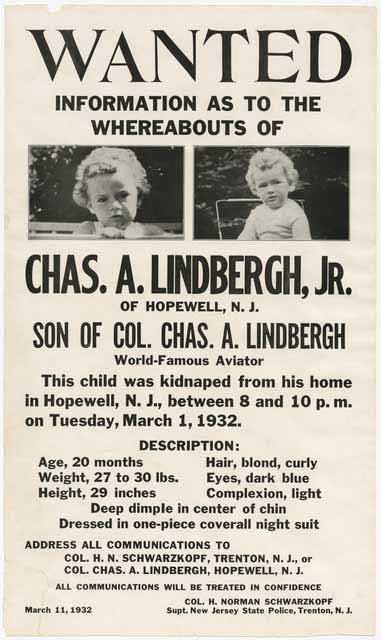
Lindbergh kidnapping
On March 1, 1932, Charles Augustus Lindbergh Jr. (born June 22, 1930), the 20-month-old son of colonel Charles Lindbergh and his wife Anne Morrow Lindbergh, was murdered after being abducted from his crib in the upper floor of the Lindberghs' home, Highfields, in East Amwell, New Jersey, United States.[1] On May 12, the child's corpse was discovered by a truck driver by the side of a nearby road.[2][3]
Lindbergh kidnapping
Hopewell Township, New Jersey, U.S.
March 1, 1932
Charles Augustus Lindbergh Jr., aged 1
Ashes scattered in the Atlantic Ocean
Inconclusive; possibly ransom
Two lawsuits filed by Hauptmann's wife against the state of New Jersey, arguing his innocence (both dismissed)
In September 1934, a German immigrant carpenter named Bruno Richard Hauptmann was arrested for the crime. After a trial that lasted from January 2 to February 13, 1935, he was found guilty of first-degree murder and sentenced to death. Despite his conviction, he continued to profess his innocence, but all appeals failed and he was executed in the electric chair at the New Jersey State Prison on April 3, 1936.[4] Hauptmann's guilt or lack thereof continues to be debated in the modern day. Newspaper writer H. L. Mencken called the kidnapping and trial "the biggest story since the Resurrection".[5][6] Legal scholars have referred to the trial as one of the "trials of the century".[7] The crime spurred the U.S. Congress to pass the Federal Kidnapping Act (commonly referred to as the "Little Lindbergh Law"), which made transporting a kidnapping victim across state lines a federal crime.[8]
Kidnapping[edit]
At approximately 9 p.m. on March 1, 1932, the Lindberghs' nurse, Betty Gow, found that 20-month-old Charles Augustus Lindbergh Jr. was not with his mother, Anne Morrow Lindbergh, who had just come out of the bath. Gow then alerted Charles Lindbergh who immediately went to the child's room, where he found a ransom note, containing poor handwriting and grammar, in an envelope on the windowsill. Taking a gun, Lindbergh went around the house and grounds with the family butler, Olly Whateley;[9] they found impressions in the ground under the window of the baby's room, pieces of a wooden ladder, and a baby's blanket.[10] Whateley telephoned the Hopewell police department while Lindbergh contacted his attorney and friend, Henry Breckinridge, and the New Jersey state police.[10]